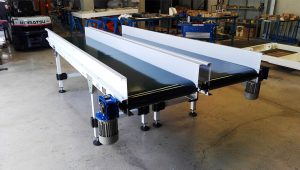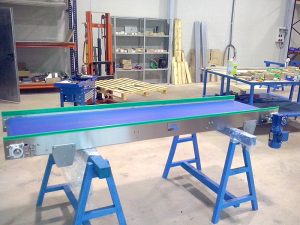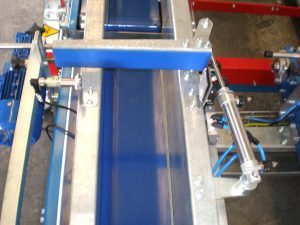Manufacture of Conveyor Belts
The manufacture of conveyor belts is a crucial process in the industry, since these tools are fundamental in the automation and efficiency of production in various areas. In this article, we are going to explore in detail the manufacturing process of conveyor belts,
its importance in the industry and the factors to consider when choosing a conveyor belt for your company.
What are conveyor belts?
Conveyor belts are mechanical tools used to transport products and materials in a variety of industries, such as food, pharmaceutical,
automotive and logistics. These belts are designed to move large amounts of materials from one point to another, making them ideal for automating production and transportation in a wide range of applications.
Conveyor belts consist of a support structure, a conveyor belt and a motor to drive the belt. The conveyor belt is an endless belt that moves on rollers or pulleys, driven by a motor. The conveyor belt can be made of various materials, including rubber, PVC, urethane, and metal,
according to the specific needs of the industry and the type of material to be transported.
How are conveyor belts made?
The manufacturing process of conveyor belts is a complex process that involves various stages and techniques. Next,
The typical steps involved in the manufacture of conveyor belts are described:
Design:
The first step in the manufacture of a conveyor belt is the design. A number of factors must be considered, such as load capacity, belt speed, type of material to be conveyed,
the length of the belt and the environment in which the conveyor belt will be used. The design must also take into account safety standards and industry requirements.
Materials selection:
Once the conveyor belt has been designed, the materials necessary to manufacture the conveyor belt are selected,
the support structure and electrical and mechanical components. It is important to choose high-quality materials to ensure the durability and safety of the conveyor belt.
Cutting And Assembly Of The Conveyor Belt:
The transport belt is cut based on the required size and shape.
The conveyor belt is assembled using welding, bonding, or mechanical bonding techniques, depending on the type of belt material and the preferred technique.
Support Structure Assembly:
The support structure is assembled using welding or mechanical fastening techniques,
depending on the type of material of the structure.
Installation Of Electrical And Mechanical Components:
Electrical and mechanical components, such as motors, sensors, and controls, are installed on the conveyor.
Tests And Adjustments:
Once the conveyor belt has been assembled,
Testing and adjustments are made to make sure the belt moves correctly, meets load and speed requirements, and is safe and reliable. Any issues are resolved and adjusted before the conveyor is shipped to the business or customer.
 Why are conveyor belts important?
Why are conveyor belts important?
Conveyor belts are important to the industry for several reasons:
Process automation:
Conveyor belts are essential for the automation of production and the transport of materials. They allow large amounts of materials to be moved with little or no human effort,
which increases efficiency and productivity.
Costs reduction:
Conveyor belts reduce labor costs and increase efficiency, which helps reduce production costs.
Security And Reliability:
Conveyors are designed to meet industry safety standards and specifications, ensuring safe and reliable material transportation.
Personalization:
Conveyors can be customized to meet specific industry and customer needs,
which makes them flexible and adaptable to a wide range of applications.
How to choose the right conveyor belt?
When choosing a conveyor belt for your company, there are several factors that you should consider:
Type of material:
The type of material to be conveyed will affect the choice of conveyor belt.
The materials can be heavy, abrasive or corrosive, and each will require a specific conveyor belt.
Loading capacity:
You must make sure that the conveyor belt has the adequate load capacity for your needs. If the tape does not have enough load capacity,
there could be performance and durability issues.
Length And Speed:
The length and speed of the conveyor belt are also important factors to consider. You need to make sure that the conveyor belt is the right length and speed to transport your materials efficiently.
Around:
The environment in which the conveyor belt will be used is also important. If the belt will be used in a humid or corrosive environment, you will need a conveyor belt with materials that are resistant to corrosion and oxidation.
Safety rules:
Conveyor belts must meet safety standards and industry requirements. Make sure that the conveyor belt you choose meets the necessary safety and quality requirements.
In conclusion:
Conveyor belts are important tools for the automation and transport of materials in the industry.
Conveyor belt manufacturing is a detailed and careful process that requires skill and experience to produce high-quality belts that meet industry performance and safety requirements.
 When choosing a conveyor belt, you should consider the type of material that will be conveyed, the load capacity, the length and speed of the belt, the environment in which it will be used and the safety and quality standards that must be met.
When choosing a conveyor belt, you should consider the type of material that will be conveyed, the load capacity, the length and speed of the belt, the environment in which it will be used and the safety and quality standards that must be met.
In the manufacturing of conveyor belts, various materials and technologies are used to create a belt that is tailored to the specific needs of the customer.
High-quality materials and advanced technology ensure the safety, durability and optimum performance of the conveyor belts.
In summary, if your company needs a conveyor belt to automate production processes and transport of materials,
It is important to choose a suitable, high-quality conveyor belt that meets your specific needs. Conveyor belt manufacturing requires skills and experience, but with the help of industry-savvy professionals,
you can get a conveyor belt that meets the highest quality and safety standards.


